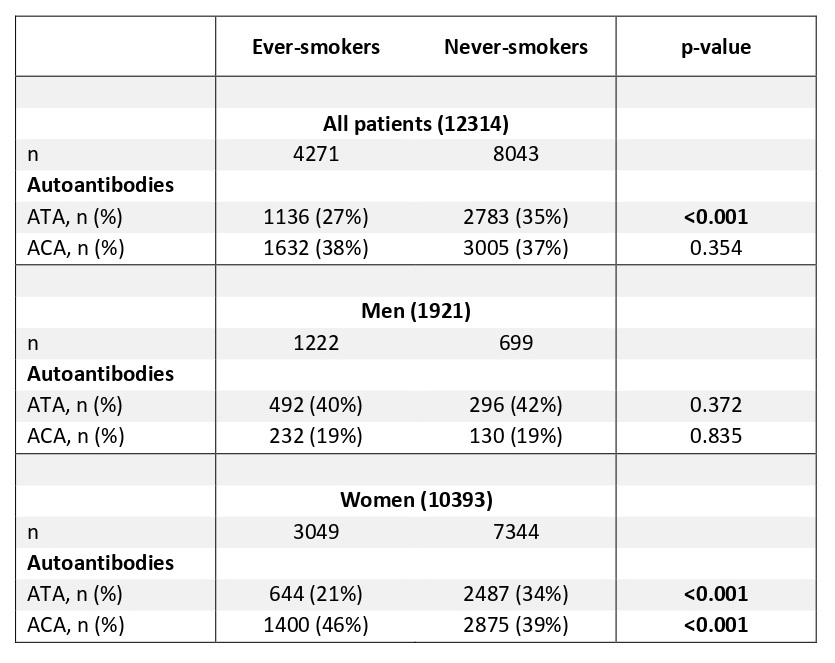Session Information
Date: Sunday, November 12, 2023
Title: (0609–0672) Systemic Sclerosis & Related Disorders – Clinical Poster I: Research
Session Type: Poster Session A
Session Time: 9:00AM-11:00AM
Background/Purpose: In rheumatoid arthritis, cigarette smoking confers a risk for anti-CCP positive disease and the risk further increases in smokers carrying specific HLA DRB1-variants. These observations have fuelled the hypothesis that, in susceptible individuals, chronic exposure to specific antigens, (for example in the lungs) can trigger a targeted chronic autoimmune response. With this in mind, the lower frequency of anti-topoisomerase antibodies (ATA) observed among never-smokers in systemic sclerosis (SSc) is intriguing. We evaluated in the EUSTAR database the effect of smoking on ATA expression, both for the total cohort and also for males and females separately. We evaluated how sex, smoking and ATA/anticentromere (ACA) expression interact and impact on disease progression.
Methods: All SSc patients with complete information about smoking status available were included and categorised as “never-smokers” or “ever-smokers”. Chi-square test and logistic regression were used to evaluate differences in ATA and ACA expression between ever-smokers and never-smokers. A possible dose-response effect was evaluated using logistic regression with pack/years or smoking duration as predictors. We evaluated the association between disease progression, smoking and antibody expression using Kaplan-Meier curves and multivariate Cox regression models corrected for age and sex and with stratification for ACA/ATA status.
Results: In total 12314 patients were included (Table 1). In women 34% of never-smokers were ATA+ compared to 21% of ever-smokers (p < 0.001; Table 2).Ever-smoking females had lower risk of ATA+ [OR 0.523 (95% CI 0.473 – 0.578), p < 0.001] and higher exposure further decreased the risk of being ATA+ [OR number of pack/years 0.988 (95% CI 0.978 – 0.997), p= 0.009; OR years smoking duration 0.963 (95% CI 0.952 – 0.975), p < 0.001]. Ever-smoking females had increased risk to be ACA+ [OR 1.320 (95% CI 1.212 – 1.437),p< 0.001] and a higher number of pack/years further increased risk of ACA expression [OR 1.012(95% CI 1.002 – 1.021), p= 0.014].In men, the proportion of ATA+ was comparable between non-smokers and ever-smokers, but higher exposure decreased the risk of ATA expression (OR 0.989 (95% CI 0.979 – 0.999), p= 0.032]. We observed different associations with disease progression depending on antibody status: in ACA+ patients, smoking was associated with mortality (HR 1.3, 95%CI 1.0–1.6), cardiac involvement (HR 1.2, 95%CI 1.1–1.4) and lower risk of pulmonary hypertension (HR 0.8, 95%CI 0.6–1.0), while in ATA+ patients, smoking was a risk factor for mortality (HR 1.4, 95%CI 1.1–1.8) and digital ulcers (HR 1.2, 95%CI 1.0–1.3) (Figure 1).
Conclusion: In this large EUSTAR cohort we observe a clear association between smoking exposure and ATA expression in SSc, particularly in females. For the first time, we describe a negative dose-response relationship between cumulative cigarette exposure and ATA expression, pointing at a possible etiopathogenetic link between smoking and ATA expression. Intruigingly, smoking exposure had different impact on disease manifestations depending on ATA/ ACA status.
Legend: DLCO: diffusing capacity of the lungs for carbon monoxide; FVC: forced vital capacity; IQR: interquartile range; SD: standard deviation. Disease duration was defined since the date of onset of Raynaud’s phenomenon.
To cite this abstract in AMA style:
Ciaffi J, Liem S, Ahmed S, Hoekstra E, Wiland P, Atsuma T, Szucs G, Balbir-Gurman A, Czirjak L, Zanatta E, Koetter I, Henes J, Matucci Cerinic m, Airò P, Ursini F, Huizinga T, de Vries-Bouwstra J. Cigarette Exposure in Systemic Sclerosis: Impact on Autoantibody Expression and Disease Manifestations: Analysis of the EUSTAR Cohort [abstract]. Arthritis Rheumatol. 2023; 75 (suppl 9). https://acrabstracts.org/abstract/cigarette-exposure-in-systemic-sclerosis-impact-on-autoantibody-expression-and-disease-manifestations-analysis-of-the-eustar-cohort/. Accessed .« Back to ACR Convergence 2023
ACR Meeting Abstracts - https://acrabstracts.org/abstract/cigarette-exposure-in-systemic-sclerosis-impact-on-autoantibody-expression-and-disease-manifestations-analysis-of-the-eustar-cohort/



